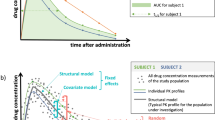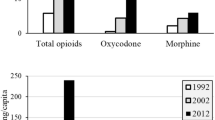Abstract
Azosemide, 5, 10, 20, and 30 mg/kg, was administered both intravenously and orally to determine the pharmacokinetics and pharmacodynamics of azosemide in rats (n=7–12). The absorption of azosemide from various segments of GI tract and the reasons for the appearance of multiple peaks in plasma concentrations of azosemide after oral administration were also investigated. After intravenous (iv) dose, the pharmacokinetic parameters of azosemide such ast 1/2, MRT, VSS, CL, CLR, and CLNR were found to be dose-dependent in the dose ranges studied. The percentages of the iv dose excreted in 8-hr urine as azosemide, MI (a metabolite of azosemide), glucuronide of azosemide, and glucuronide of MI—expressed in terms of azosemide—were also dose-dependent in the dose ranges studied. The data above suggest saturable metabolism of azosemide in rats. The measurements taken after the iv administrations such as the 8 hr urine output, the total amount of sodium and chloride excreted in 8-hr urine per 100 g body weight, and diuretic, natriuretic, kaluretic, and chloruretic efficiencies were also shown to be dose-dependent. However, the total amount of potassium excreted in 8-hr urine per 100 g body weight was dose-independent. Similar dose-dependency was also observed following oral administration. Azosemide was absorbed from all regions of GI tract studied and approximately 93.5, 79.1, 86.1, and 71.5% of the doses (5, 10, 20, and 30 mg/kg, respectively) were absorbed between 1 and 24 hr after oral administration. The appearance of multiple peaks after oral administration is suspected to be due mainly to the gastric emptying pattern. The percentages of azosemide absorbed from the GI tract as unchanged azosemide for up to 24 hr after oral doses of 5, 10, 20, and 30 mg/kg were significantly different with doses (decreased with increasing doses), suggesting that the problem of azosemide precipitating in acidic gastric juices or dissolution may have at least partially influenced the absorption of azosemide after oral administration.
Similar content being viewed by others
References
F. Krück, W. Bablok, E. Besenfelder, G. Betzien, and B. Kaufman. Clinical and pharmacological investigations of the new saluretic azosemide.Eur. J. Clin. Pharmacol. 14:153–161 (1978).
D. C. Brater, B. Day, S. A. Anderson, and R. Seiwell. Azosemide kinetics and dynamics.Clin. Pharmacol. Ther. 34:454–458 (1983).
D. C. Brater, S. A. Anderson, and S. Strowig. Azosemide, a “loop” diuretic, and furosemide.Clin. Pharmacol. Ther. 25:435–439 (1979).
B. Beerman and M. Grind. Clinical pharmacokinetics of some newer diuretics.Clin. Pharmacokin. 13:254–266 (1987).
S. H. Lee and M. G. Lee. Stability, tissue metabolism, tissue distribution and blood partition of azosemide.Biopharm. Drug Dispos. 16:547–561 (1995).
F. Kuzuya. Phase I study of azosemide (SK-110): single and multiple dose study.Int. J. Clin. Pharmacol. Ther. Toxicol. 21:10–23 (1983).
S. H. Lee, W. G. Shin, M. G. Lee, and N. D. Kim. Arterial and venous blood sampling in pharmacokinetic studies: Azosemide in rabbits.Biopharm. Drug Dispos. 15:305–316 (1994).
S. H. Lee, M. G. Lee, and N. D. Kim. Pharmacokinetics and pharmacodynamics of bumetanide after intravenous and oral administration to rats: Absorption from various GI segments.J. Pharmacokin. Biopharm. 22:1–17 (1994).
S. H. Lee and M. G. Lee. Determination of azosemide and its metabolite in plasma, blood, urine and tissue homogenates by high-performance liquid chromatography.J. Chromatogr. Biomed. Appl. 656:367–372 (1994).
T. Li, M. G. Lee, and W. L. Chiou. Effects of the rate and composition of fluid replacement on the pharmacokinetics and pharmacodynamics of intravenous furosemide.J. Pharmacokin. Biopharm. 14:495–509 (1986).
W. H. Yoon, S. H. Lee, and M. G. Lee. Effects of the rate and composition of fluid replacement on the pharmacokinetics and pharmacodynamics of intravenous bumetanide.J. Pharm. Sci. 84:236–242 (1995).
M. G. Lee and W. L. Chiou. Evaluation of potential causes for the incomplete bioavailability of furosemide: Gastric first-pass metabolism.J. Pharmacokin. Biopharm. 11:623–640 (1983).
F-H. Hsu, T. Prueksaritanont, M. G. Lee, and W. L. Chiou. The phenomenon and cause of the dose-dependent oral absorption of chlorothiazide in rats: Extrapolation to human data based on the body surface area concept.J. Pharmacokin. Biopharm. 15:369–386 (1987).
M. Gibaldi and D. Perrier.Pharmacokinetics, Second Ed., Marcel Dekker, New York 1982.
W. L. Chiou. Critical evaluation of potential error in pharmacokinetic studies using the linear trapezoidal rule method for the calculation of the area under the plasma level-time curve.J. Pharmacokin. Biopharm. 6:539–546 (1978).
S. H. Kim, Y. M. Choi, and M. G. Lee. Pharmacokinetics and pharmacodynamics of furosemide in protein-calorie malnutrition.J. Pharmacokin. Biopharm. 21:1–17 (1993).
W. L. Chiou. New calculation method for mean apparent drug volume of distribution and application to rationale dosage regimen.J. Pharm. Sci. 68:1068–1069 (1979).
S. H. Lee and M. G. Lee. Factors influencing the protein binding of azosemide using an equilibrium dialysis technique.Biopharm. Drug Dispos. 16:615–626 (1995).
H. A. Ha, S. H. Lee, O. N. Kim, S. H. Kim, and M. G. Lee. Effect of water deprivation for 48 hours on the pharmacokinetics and pharmacodynamics of azosemide in rats.Res. Commun. Mol. Pathol. Pharmacol. 93:109–128 (1996).
T. Asano, T. Inoue, and M. Kurono. Disposition of azosemide. I. Distribution, metabolism and excretion following intravenous administration to rats.Yakugaku Zasshi 104:1181–1190 (1984).
T. Inoue, M. Hayashi, A. Inoue, Y. Nakayama, Y. Hori, and M. Okada. Behavior of azosemide (SK-110) in the body—A study on ADME of azosemide in rats, rabbits, dogs and monkeys.Kiso to Rinsho (The Clinical Reports)18:429–440 (1984).
L. L. Boles Ponto and R. D. Schoenwal., Furosemide (Frusemide). A pharmacokinetic/pharmacodynamic review (Parts I and II).Clin. Pharmacokin. 18:381–408; 460–471 (1990).
B. Odlind, B. Beermann, and B. Lindström. Coupling between renal tubular secretion and effect of bumetanide.Clin. Pharmacol. Ther. 34:805–809 (1983).
M. G. Lee, T. Li, and W. L. Chiou. Effects of intravenous infusion time on the pharmacokinetics and pharmacodynamics of the same total dose of furosemide.Biopharm. Drug Dispos. 7:537–547 (1986).
G. Giebisch. In M. Martines-Maldonado (ed),Methods of Pharmacology, Vol. 4A, Plenum, New York, pp. 121–164, 1976.
V. S. Chungi, I. W. Dittert, and R. B. Smith. Gastrointestinal sites of furosemide absorption in rats.Int. J. Pharm. 4:27–38 (1979).
M. G. Lee, M.-L. Chen, and W. L. Chiou. Pharmacokinetics of drugs in blood II: Unusual distribution and storage effect of furosemide.Res. Commun. Chem. Pathol. Pharmacol. 34:17–23 (1981).
H. W. Chang, E. J. Yoon, M. G. Lee, and N. D. Kim. Pharmacokinetics of drugs in blood VI: Unusual distribution and storage effect of bumetanide.Seoul Univ. J. Pharm. Sci. 13:1–17 (1988).
Y. Suzuki, M. Ito, and T. Komura. Effects on diuresis, plasma renin activity, and urinary prostaglandin E excretion in normal rats.Folia Pharmacol. Japon 79:317–325 (1982).
M. Hayashi, K. Nakano, K. Asano, K. Takahashi, M. Takeda, M. Kurono, and Y. Suzuki. Pharmacological studies of azosemide (SK-110), a diuretic (1). Diuretic action in normal animals.Oyo Yakuri 28:819–835 (1984).
M. Hayashi, K. Nakuno, K. Mori, K. Niu, K. Mizuno, A. Yamamoto, M. Kouketsu, M. Kurono, and Y. Suzuki. Pharmacological studies of azosemide (SK-100), a diuretic (2). Diuretic action in rats with experimental model disease.Oyo Yakuri 28:837–849 (1984).
Author information
Authors and Affiliations
Additional information
This paper was supported in part by Non-Directed Research Fund, Korea Research Foundation, 01-F-0124, 1994. This paper is taken from a dissertation submitted by Sun H. Lee to the Graduate School, Seoul National University, in partial fulfillment of Doctor of Philosophy Degree requirements.
Rights and permissions
About this article
Cite this article
Lee, S.H., Lee, M.G. Pharmacokinetics and pharmacodynamics of azosemide after intravenous and oral administration to rats: Absorption from various GI segments. Journal of Pharmacokinetics and Biopharmaceutics 24, 551–568 (1996). https://doi.org/10.1007/BF02353480
Received:
Accepted:
Published:
Issue Date:
DOI: https://doi.org/10.1007/BF02353480




